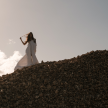The History of Coronations EXPLAINED
Bite-sized Facts to Talk About When Watching King Charles III's Coronation in May 2023

On June 2nd, 1953, Queen Elizabeth II’s coronation was the first royal event broadcast on national television. It was a historical breakthrough, with over 27 million viewers in the UK (and 36 million outside the UK) watching the late queen’s ceremony. There were more than 2,000 journalists and 500 photographers from 92 nations covering the iconic moment. With today’s digital modernization (including the significance of social media), who knows how many people will tune in to King Charles III’s coronation?
Coronations became a European tradition when the influence of church increased its involvement in the state. The core of the ceremony is the "unction", which is the act of anointing a monarch with holy oil. This signals the conferment of God’s grace upon a ruler. The ceremony combines not only religion but aspects of the UK’s uncodified constitution and a degree of theatre. The contemporary version of coronations dates back to 1902, when King Edward VII was crowned.
During the procession, the sovereign takes the oath. The wording of the oath itself has varied throughout the centuries. Queen Elizabeth II's oath was according to the law and the people, which was an exercise of justice and mercy, and to maintain the Church of England. The oath was symbolized by the four swords in the coronation regalia (the Crown Jewels). After taking the oath, the sovereign is anointed, blessed, and consecrated by the archbishop. This happens while the sovereign is seated in the coronation chair, which has been around since the 1300s. The coronation chair was made by King Edward I to enclose the famous Stone of Scone. The chair was brought from Scotland to the Abbey in 1296, where Edward I placed it in the care of Abbot of Westminster. It has been used by every sovereign since 1626. After receiving the orb and scepters, the Archbishop places St. Edward's Crown on the Sovereign's head. If the sovereign is a king, the queen consort (unless decided otherwise) is also crowned with the king in a similar but simpler ceremony. If the sovereign is a queen, her consort is neither crowned nor anointed.
St. Edward's Crown was made in 1661, the same crown that was placed on Queen Elizabeth II's head at her coronation. This crown is then traded for the Imperial State Crown at the end of the coronation. The Imperial State Crown weighs 4 pounds and 12 ounces and is made of solid gold. It is set with 2,868 diamonds, 17 sapphires, 11 emeralds, 269 pearls, and 4 rubies! The crown contains other famous jewels in the collection, including the Black Prince's Ruby, the Stuart Sapphire, and the Culling II diamond (which is the largest diamond in the world).
There are other trivia facts I stumbled on when researching coronations. England once had one set of joint monarchs, William III and Mary II. James II was abdicated by Parliament once they felt that he abandoned his kingdom. So, they offered William III and Mary II (who were husband and wife, btw) the opportunity to rule England together. Also, there were only two kings who never had coronations. They were Edward V (the boy king) and Edward VIII. While Edward V's fate was quite tragic, Edward VIII abdicated 11 months after he succeeded the throne.
With Queen Victoria, her coronation in 1838 renewed appreciation for the true religious meaning of the ceremony. This was highlighted because the 18th and 19th century saw many public spectacles of the ceremony by previous monarchs that sometimes overshadowed the religious significance of coronations.
As another random trivia fact, the youngest monarch to be crowned was Henry VI, who became king at only 8 months old. As his story goes, his father, Henry V, and grandfather, Charles VI of France, passed within months of each other. This left Henry VI with the throne of England in 1429 and the throne of France in 1431. Imagine being a barely 1-year-old monarch!
About the Creator
Norma Jane
Instagram: @mayurwordsbearfruit






Comments
There are no comments for this story
Be the first to respond and start the conversation.